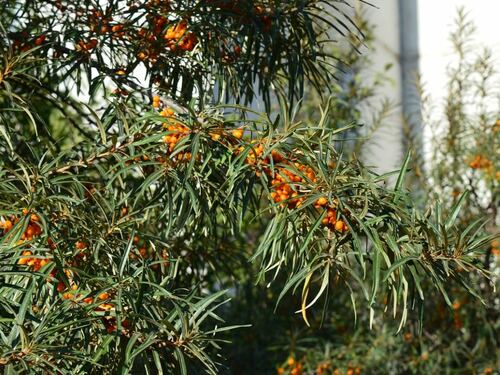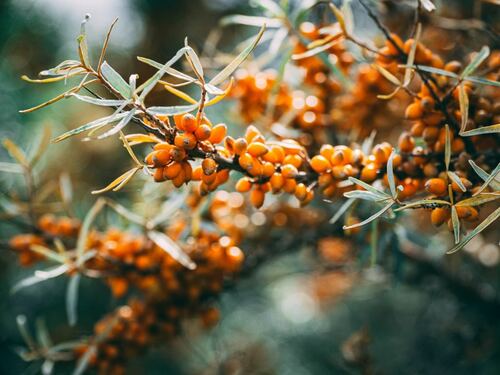Hippophae Rhamnoides: The Common Sea Buckthorn
Botanical Characteristics
Description
Sea Buckthorn is a thorny shrub characterized by its narrow lanceolate leaves that alternate along the branches. These leaves are silvery green, adding to the plant’s unique aesthetic. One of the notable features of sea buckthorn is its dioecious nature, meaning that individual plants are either male or female. Male plants produce clusters of four to six apetalous flowers, while female plants bear a single apetalous flower with one ovary and one ovule.
Pollination and Fruit Production
Sea buckthorn relies on wind pollination for fertilization. Once fertilized, the plant produces fruit that grows in round clusters, similar in appearance to blueberries. The fruit ranges in color from yellow to orange and is known for its vibrant hue and nutritional value. The plant’s robust root system and ability to thrive in mineral-deficient soils make it an excellent choice for soil stabilization and erosion control .
Ecological and Agricultural Benefits

Leafy Sea Buckthorn Branches with Fruit – Image by Alina Kuptsova from Pixabay
Soil Health and Erosion Control
Sea buckthorn is highly valued for its ecological benefits. It can thrive in poor soil conditions due to its symbiotic relationship with nitrogen-fixing bacteria in its roots. This unique adaptation not only enriches the soil but also promotes soil health and sustainability. Additionally, sea buckthorn’s extensive rooting system helps prevent soil erosion, making it an ideal plant for land reclamation projects.
Drought and Salt Tolerance
Sea buckthorn’s resilience extends to its ability to withstand drought and salt conditions, which makes it a suitable choice for challenging environments such as the San Francisco Bay Area. Its adaptability to various soil types and weather conditions enhances its appeal for landscaping and environmental management.
Medicinal and Cosmetic Uses

A Glass of Sea Buckthorn Tea – Photo by Katie Azi on Unsplash
Holistic Medicine
Sea buckthorn has long been celebrated in holistic medicine for its therapeutic properties. Rich in vitamins C, A, and B, the plant’s various parts can be used to create oils , teas, salves, and syrups. The active substances in sea buckthorn, including polyphenols , exhibit antiviral, antibacterial, and antifungal properties. The plant is commonly used to address ailments such as the common cold, digestive issues, infections, and even cancer.
Skincare and Cosmetic Benefits
Due to its significant regenerative properties, sea buckthorn is a popular ingredient in cosmetic products. It is renowned for its ability to protect the skin from UV radiation, alleviate dryness and eczema, and reduce signs of aging. The plant’s extracts are frequently used in creams and lotions for their skin-nourishing benefits.
Agricultural Uses and Cultural Significance

Close-up of a Fruit-laden Sea Buckthorn Branch – Photo by Philipp Deus on Unsplash
Animal Feed and Nutrition
In certain regions of Europe and Asia, sea buckthorn is used as a feed supplement for animals. Its nutritional properties positively impact animal health, enhancing overall wellness. In Greece, for example, young leaves and shoots are fed to racehorses to boost weight gain and improve coat health, resulting in a shinier appearance.
Sea Buckthorn in the United States
While sea buckthorn is more commonly found in China and parts of Europe and Asia, its presence in the United States is relatively rare. However, it is highly regarded by botanists and gardeners for its unique characteristics and benefits. In the San Francisco Bay Area, its drought and salt tolerance make it a valuable addition to local landscapes.
Conclusion
Hippophae rhamnoides , or sea buckthorn, is a versatile and resilient plant with a wide range of ecological, medicinal, and agricultural benefits. Its ability to improve soil health, resist harsh environmental conditions, and contribute to holistic wellness makes it a noteworthy species for both practical applications and garden enthusiasts. Whether you are interested in its environmental impact or its use in natural remedies and cosmetics, sea buckthorn offers a wealth of advantages worth exploring.
Originally posted on August 29, 2018.


